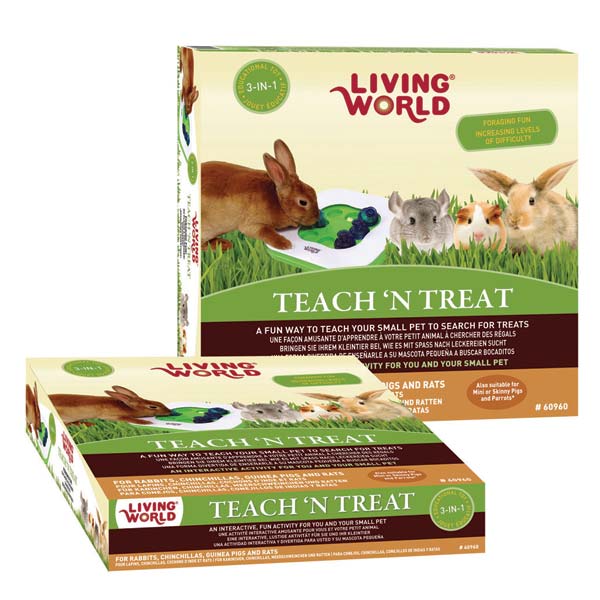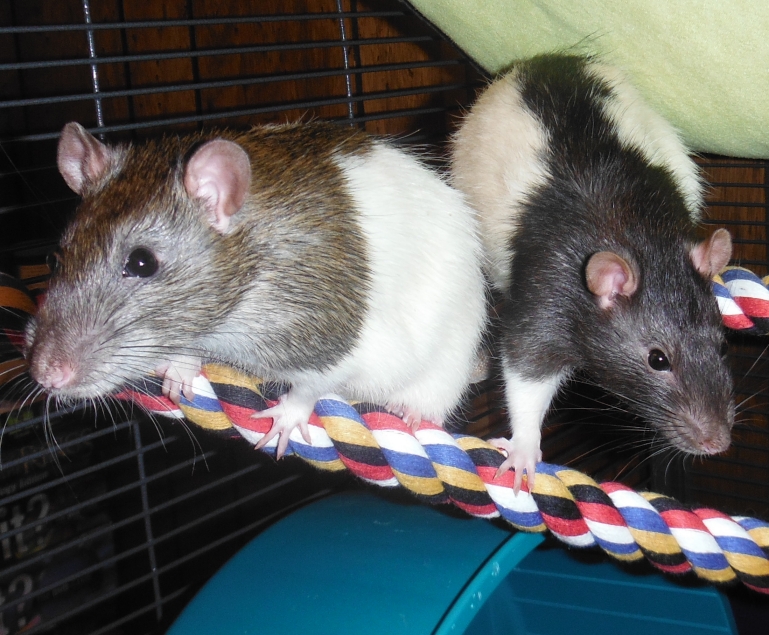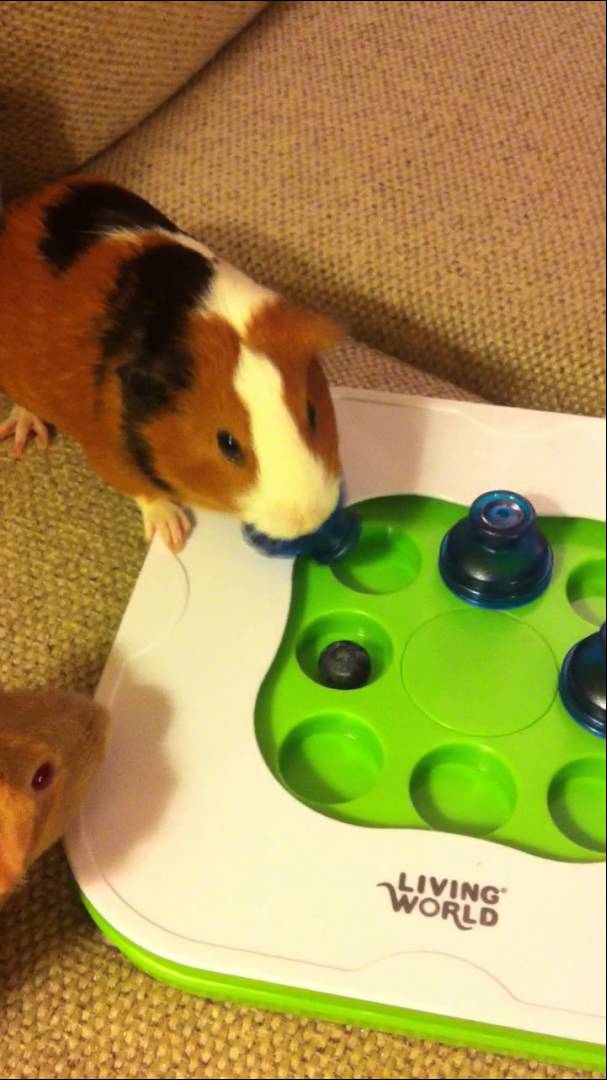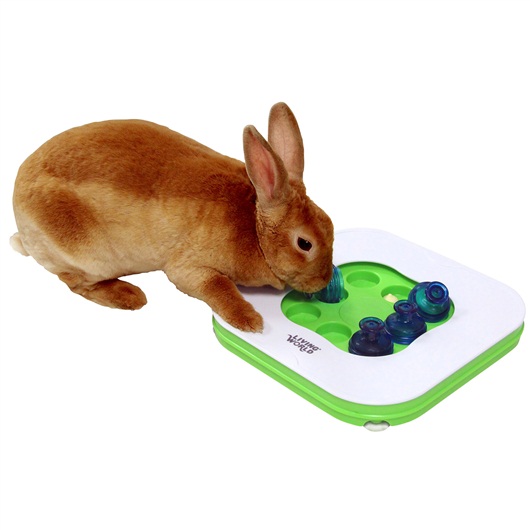Living World: Giving Guinea Pigs, Rabbits, and Other Small Animals A Fun Foraging Experience
We have had this Living World product in our house for several years and have included it in our rotating variety of stimulating toys for some time now. Having rats, I can only speak from the experience of their interaction with it, but I expect that animals like guinea pigs and rabbits might get more out of it than even the rats! All of our rats have been too quick to learn the trick of the toy to really spend a lot of time with it, even if they love using it. However, you can make the game more challenging for pets.
The treat tray consists of a base and various removable buttons which combine in several different ways to give three levels of training in all, with only one or two minor adjustments to the toy itself. The directions are multilingual and easy to follow, with clear illustrations and suggestions for further training. The main platform also has suction cups for stabilization, which comes in handy for larger small pets, like guinea pigs and rabbits. My only instant advice is to KEEP THE BOX. The toy has multiple parts that you won’t be using all at once and you will need to keep the unused knobs and pieces in a safe location. None of the parts are tiny, but each is needed in various steps in the training process, so it’s important to keep track of them.
How To Know If This Toy Is Right For Your Pet
As I said, we have rats, so my experience with this toy will be slightly different from those with guinea pigs, rabbits or other small animals, but most small animals should enjoy this product as it helps to stimulate their natural foraging behaviors. Our rats Whisper and North helped us break down the various stages of the Living World Teach N’ Treat to help you decide if this toy is right for your pet.
Stage one requires the base, the flat center button (which covers the hole in the center of the base, needed in the third stage), and the one, large disc. You plug the center button in place, fill the treat pockets with something yummy and simply slide the large disc into place to cover the treats. The point of this stage is to teach your pet that this is a treat tray, with a little fun added on the side. It isn’t long at all before curious critters discover that something yummy hides under the disc. North, who loves food, found his treats right away. Whisper took a little coaxing, but once I shifted the disc a little for him, he worked out what he was meant to do. All together the first day of this stage took about eight minutes until the rats completely lost interest, once they had eaten up all the food, of course. We waited a few days and introduced the toy again. Each time we brought the tray back the play time shortened until it got down to a little more than two minutes. Then we moved on to phase two.
How To Make The Game More Challenging For Pets
In the second stage you keep the base as it is, take out the big disc and put the four small knobs over some of the treat pockets in the base. The point of this stage is to play hide and seek with the food. You can make the game more challenging by putting down all four knobs, but hiding treats under only a few of them, though to start with you should put food under all of the knobs to prevent your pet from getting discouraged in their hunt. Whisper loved this stage and actually lifted the knobs with his teeth, as the directions state is the intent of the exercise. North, however, simply pushed everything over like the bulldozer he is. This phase wasn’t at all stimulating for him. For most of our rats in the past, this has been the least stimulating of the phases. They simply crave a more difficult mental challenge. The instructions do give further ideas for training on this stage, such as teaching your pet to put the knob in a box nearby or to put it back in the hole where they found it, but we haven’t done this with our rats. A helpful note for guinea pig and rabbit owners: the knobs have holes on the top for you to stick a piece of hay in, to encourage them to hunt inside for more food. You can stop using the holes to make this phase more of a challenge.
With the second stage quickly completed, it was time to move on to stage three, which requires the square “center guard” instead of the small, flat middle button of the first two stages. Switch those out, put the knobs back and you have an instant knob track that you can hide treats under. This is a great stage to watch because your pets already know there is food to be found under the knobs. Now they quickly discover that the knobs can make a traffic jam and it takes more effort to get those last few treats once the knobs are all pushed together into a compact group. Whisper was still trying to lift the knobs after the first few days of stage three, but North picked up on the pushing skill very quickly. They started out with a five minute interest level and worked it down to about two or three minutes. A simple way to make this game more challenging for pets is to provide only one or two treats. While the small animal is foraging , the knobs get bunched together and they need to work out how to get to that one treat that ended up under all those knobs.
Variety Is What’s Best For Your Pet
It is important to point out that variety is the key with these types of toys. North and Whisper tested this Living World product over a series of months to see if the toy is right for your pet, and never used it two days in a row. You don’t want them to forget all about the toy, but you don’t want it to be to them what a vending machine is with us. How many of us actually get excited about watching those people-treats drop down into the tray once we’re all grown up and know how it works? Switch stages on your pet once they have worked out how each one works. Maybe jump from one to three and back to two. Maybe give them a week away from it and then pull it back out again, just for kicks. You might also want to try a variety of treats. We use small treats for our rats, but you could put chunks of carrot or other animal food into your tray. The tray is easy to clean and solid plastic, so even animals who eat soft foods as a part of their diet could find a yummy berry inside one day.
There are so many small animal toys that help your rat, rabbit or guinea pig to chew, burrow, or hide, but there are very few that make the game more challenging for pets, and remind us that these animals forage for food. In our household, we have found that this is an excellent substitute for the large box full of shredded paper that we once used. Sure the rats could forage in there, but within a minute they figured out that all the treats settled to the bottom of the box, and it wasn’t any different than covering up a carrot with a blanket and having them find it. This toy provides the stimulation your pet requires and the easy clean up that pet owners love. It comes highly recommended from our household–and Living World!
Conclusions On The Living World Teach N’ Treat
Pros:
- Easy to Clean
- Easy to Assemble
- Stimulating for Pets
- Stabilization Enhancements
Cons:
- Keep track of the parts you aren’t using!
This toy is right for your pet! Follow this link to purchase:
![]() Mirrani Houpe, our Small Animal Editor, has had rats since she took home her first little boy once they both completed the second grade. Since that time she has purchased, rescued and bred many kinds of rats, from many backgrounds. She may not be a vet, psychology major, or scientist, but her babies have her very well trained when it comes to how to care for them. She is constantly working with her family’s veterinarian to come up with new and innovative ways to love and care for the most often misunderstood rodent in the pet world. You can e-mail her at mirrani@yourpetspace.info
Mirrani Houpe, our Small Animal Editor, has had rats since she took home her first little boy once they both completed the second grade. Since that time she has purchased, rescued and bred many kinds of rats, from many backgrounds. She may not be a vet, psychology major, or scientist, but her babies have her very well trained when it comes to how to care for them. She is constantly working with her family’s veterinarian to come up with new and innovative ways to love and care for the most often misunderstood rodent in the pet world. You can e-mail her at mirrani@yourpetspace.info





